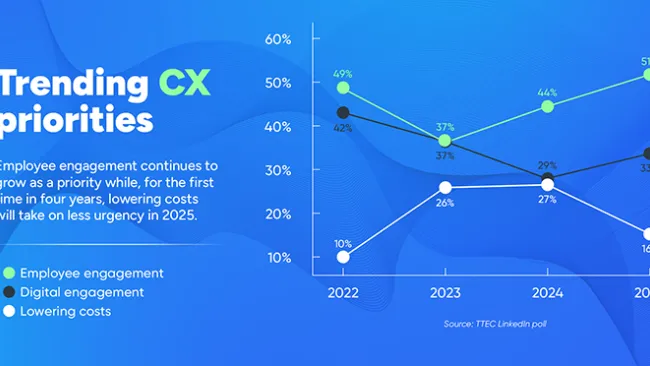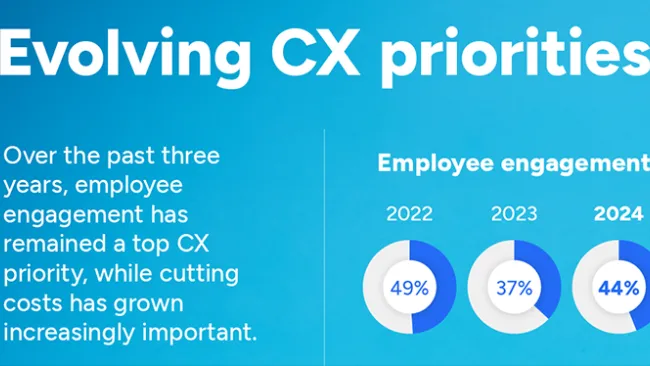The modern workplace is changing so rapidly, it can feel overwhelming for companies trying to keep up. For many, the biggest change over the past year has undoubtedly been the growing number of employees working from home.
Work-at-home arrangements bring many upsides. They help keep employees safe as the COVID-19 pandemic nears the one-year mark, eliminate wasteful commutes, and provide employment opportunities across geographies. And many companies are finding work-at-home setups make for more productive employees.
But how do companies provide a great employee experience when the traditional workplace setting is gone? How can employees feel engaged and connected—to each other and their employer—when they are physically separated?
The importance of the employee experience (EX)
An engaged workforce brings many well-documented advantages to a company. Employees who like their job and feel like valued members of the team are more productive and innovative than those who aren’t, which brings inherent value. Employees who have a great experience in the workplace are less likely to leave their jobs, cutting down on attrition; and positive employee engagement leads to improved customer engagement down the road.
EX has always been important to a brand’s success, but during this time—when employees are burned out, stressed, and struggling to find work-life balance—it has never been more essential.
Yet even prior to the pandemic, many companies struggled to prioritize employee experience. A Glint study that polled 273 HR professionals, worldwide and from businesses of all sizes, between November 2019 and January 2020 found only 11 percent rated their organizations’ EX as “excellent.” Less than half (47 percent) said they offered good or excellent employee experience, while 37 percent rated theirs as average. Like with other corporate initiatives that were slowly improving, 2020 accelerated the need to strengthen employee engagement quickly and effectively. Here are some tips on steps companies can take.
Encourage connection in a socially distanced world
Keeping teams connected and engaged in 2021 and beyond will take some out-of-the-box thinking but will pay dividends well into the future.
One of the first steps companies should take is to identify their biggest drivers of engagement and attrition. This allows leaders to be proactive in assessing where there may be problems or gaps and improve tools and processes to address those challenges. Frequent team “pulse checks” can provide great insight and help identify problem areas.
Organizations should offer the workforce a constant stream of content: material that matters to them and will help make their jobs easier and more rewarding. It’s also critical to bring people together, even if it is in digital form. Gather teams frequently via Zoom meetings and invite them to collaborate in chat rooms. Implementing login automation, via RPA, and providing training where needed can enable team members to more easily access all the systems they need.
Creating a sense of community also is key. This can go beyond work duties, allowing team members to connect on a more personal level. Consider hosting team parties, sharing healthy recipes, hosting Zoom yoga classes, Fitness Fridays or other social activities that are easy to participate in remotely.
Across all levels, from senior management down, make virtual collaboration easy. Tools like Microsoft Teams, Slack and Yammer let employees easily communicate and share information with each other on a messaging platform; and other tools like Asana, Jira and Basecamp keep teams up-to-date on projects’ progress while also letting them share information.
Another way to keep employees engaged is to enhance the workday wherever feasible. Use mobile devices and apps to give associates more flexibility and efficiency. Technology can help them better manage scheduling and compensation. A mobile app, for instance, can alert associates of volume spikes with bonuses for those who work on short notice. Letting workers review their work hours and paycheck on their mobile devices also streamlines the process and makes for a better employee experience.
With so many moving parts to track, it can be easy to let a company’s culture fall the wayside. Doing so would be a big misstep; don’t allow company culture to get lost in the shuffle. Maintaining that unified vision and familiar atmosphere is more important than ever.
There are many ways to foster a culture that makes employees feel valued. Maintain daily huddles with teams and ask all employees to use video conferencing for their daily communications. Invite senior leaders to come to group meetings, celebrate wins and share information with teammates. Appoint a person or form a committee to organize virtual team-building activities that are connected to the company’s values. All of these things will help workers feel part of the team.
Overcoming logistical challenges to employee engagement
The world and workplace are changing quickly, and there can be some bumps in the road as companies rush to keep up while still providing great EX.
The longer teams work remotely, the more difficult it can become to keep them engaged and feeling like a cohesive unit. For all the benefits working at home brings, it can also lead to distractions and burnout, which may worsen over time.
Technology also can bring its own set challenges. Working from home isn’t feasible if the technology to make it happen isn’t accessible, understandable and usable to all who need it. Be prepared to adapt quickly as glitches or roadblocks arise; be able to provide equipment—and any necessary training to use it—as quickly as possible.
Working at home brings other logistical challenges, too. Interactions and collaborations that previously took place at a moment’s notice when everyone was in the office now have to be planned and scheduled in advance. For those used to an in-office corporate experience, the transition can be jarring.
The best ways to handle challenges as they arise are to constantly gauge employee experience and to be ready to make adjustments and change course when needed. When things go wrong, acknowledge it, let employees know their concerns have been heard, and make a plan to implement improvements. And always ensure technology is user-friendly and able to be easily scaled quickly.
Navigating the new workplace normal
As these unprecedented times continue to unfold, bringing new opportunities and challenges, remember to keep the channels of communication open.
Talk to employees, at all levels, to identify pain points and things that aren’t working for them. Use that insight and leverage human touchpoints and automation concurrently to improve employee experience.
With technology playing a huge role in the work-at-home era, it is critical to streamline technology wherever possible. Making it easier for employees to do their jobs will not only benefit a company’s bottom line but result in more engaged and productive workers that will in turn offer customers a better experience.
For more tips on engaging remote workers, check out TTEC’s blog on the topic here.
How to Keep Employees Engaged in a Remote Workplace
Build camaraderie and improve productivity in a virtual setting.















